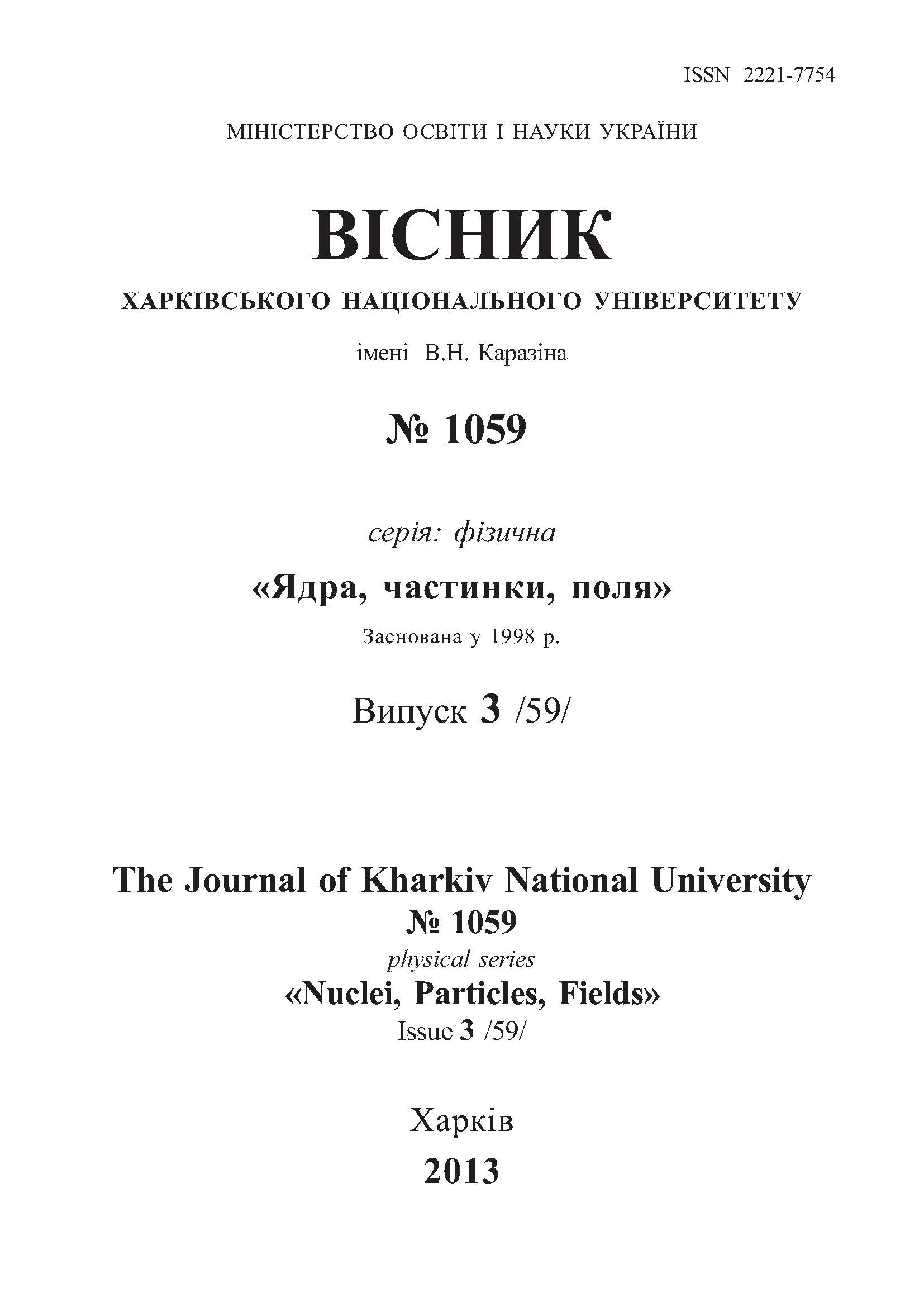Neutral strange hadron production in heavy ion collisions at energies √Snn = 8,7−17,3 Gev
Abstract
The data on the yield of neutral strange hadrons at the collisions of heavy ions(Au+Au, Pb+Pb) at energies √Snn = 8,7−17,3 GeV are presented. The ratios of yields of the neutral strange hadrons Λ0/KS0 are compared for the different centrality collisions of heavy ions. The nuclear modification factor RCP as function of transverse momentum for different colliding energies is investigated. The experimental results for Au+Au collisions at energy √Snn = 9,2 GeV are compared with the different theoretical models (UrQMD2.3, EPOS1.67, HIJING1.7), describing the dynamics of processes of heavy ions collision. It was shown that the model UrQMD2.3, describing heavy ion collisions without using partonic degrees of freedom being created in area of heavy ion interaction, gives better agreement with experimental data than the models EPOS1.67 and HIJING1.7 that use the partonic degrees of freedom.
Downloads
References
Bedangadas Mohanty (for the STAR Collaboration). STAR experiment results from the beam energy scan program at RHIС // arXiv:1106.5902 [nucl-ex].
Hohne C. SPS energy scan results and physics prospects at FAIR // Nucl. Phys. A – 2009. – Vol. 830. – P. 369C-376C.
Alt C. et al. (NA49 Collaboration). Pion and kaon production in central Pb+Pb collisions at 20A and 30A GeV: Evidence for the onset of deconfinement // Phys. Rev. C – 2008. – Vol. 77. – P. 024903-1 – 024903-10.
Tounsi A., Redlich K. Strangeness Enhancement and Canonical Suppression // arXiv:0111159 [hep-ph].
Alt C. et al., (NA49 Collaboration). Energy dependence of Lambda and Xi production in central Pb+Pb collisions at 20A, 30A, 40A, 80A, and 158A GeV measured at the CERN Super Proton Synchrotron // Phys. Rev. C – 2008. – Vol. 78. – P. 034918-1 – 034918-15.
Bormann C. (for NA49 Collaboration). Kaon-, Λ- and anti-Λ-production in Pb + Pb-collisions at 158 GeV per nucleon // J. Phys. G: Nucl. Part. Phys. – 1997. – Vol. 23. – P. 1817-1825.
Antinori F. et al. (NA57 Collaboration). Study of the transverse mass spectra of strange particles in Pb-Pb collisions at 158 A GeV/c // J. Phys. G: Nucl. Part. Phys. – 2004. – Vol. 30. – P. 823-840.
Antinori F. et al. (NA57 Collaboration). Transverse dynamics of Pb–Pb collisions at 40 A GeV/c viewed by strange hadrons // J. Phys. G: Nucl. Part. Phys. – 2006. – Vol. 32. – P. 2065-2080.
Hwa R.C. and Yang C.B. Inclusive distributions for hadronic collisions in the valon-recombination model // Phys. Rev. C – 2002. – Vol. 66. – P. 025205-1 – 025205-11; Greco V., Ko C.M. and Levai P. Parton Coalescence and the Antiproton/Pion Anomaly at RHIC // Phys. Rev. Lett. – 2003. – Vol. 90. – P. 202302-1 – 202302-4; Fries R..,Muller B., Nonaka C., Bass S.A. Hadronization in Heavy - Ion Collisions : Recombination and Fragmentation of Partons // Phys. Rev. Lett. – 2003. – Vol. 90. – P. 202303-1 – 202303-4; Molnar D., Voloshin S.A. Elliptic Flow at Large Transverse Momenta from Quark Coalescence // Phys. Rev. Lett. – 2003. – Vol. 91. – P. 092301-1 – 092301-4.
Laszlo A., Schuster T. (for NA49 Collaboration). High Spectra of Identified Particles Produced in Pb+Pb Collisions at 158 GeV/nucleon Beam Energy // Nuclear Physics A. – 2006. – Vol. 774. – P. 473-476.
Helstrup H. (for NA57 Collaboration). Results from NA57 //J. Phys. G: Nucl. Part. Phys. – 2006. – Vol. 32. – P. S89-S95.
Bass S.A., Belkacem M., Bleicher M. et al. Microscopic models for ultrarelativistic heavy ion collisions // Prog. Part. Nucl. Phys. – 1998. –Vol. 41. – P. 225-370.
Barbashov B.M., Nesterenko V.V. Model' relyativistskoy struny v fizike adronov. - M.: Energoatomizdat, 1987. – 185 s.
Xin-Nian Wang and Miklos Gyulassy. HIJING: A Monte Carlo model for multiple jet production in pp, pA, and AA collisions // Phys. Rev. D – 1991. – Vol. 44. – P. 3501-1 – 3501-15; Miklos Gyulassy and Xin-Nian Wang. HIJING 1.0: A Monte Carlo program for parton and particle production in high energy hadronic and nuclear collisions // Comput. Phys. Commun. – 1994. – Vol. 83. – P. 307-331.
Werner K. The hadronic interaction model EPOS // Nuclear Physics B (Proc. Suppl.). – 2008. – Vol. 175–176. – P. 81-87.
Authors who publish with this journal agree to the following terms:
- Authors retain copyright and grant the journal right of first publication with the work simultaneously licensed under a Creative Commons Attribution License that allows others to share the work with an acknowledgment of the work's authorship and initial publication in this journal.
- Authors are able to enter into separate, additional contractual arrangements for the non-exclusive distribution of the journal's published version of the work (e.g., post it to an institutional repository or publish it in a book), with an acknowledgment of its initial publication in this journal.
- Authors are permitted and encouraged to post their work online (e.g., in institutional repositories or on their website) prior to and during the submission process, as it can lead to productive exchanges, as well as earlier and greater citation of published work (See The Effect of Open Access).








